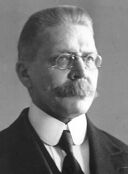Aimo Cajander
Aimo Kaarlo Cajander (4 April 1879 – 21 January 1943) was the Prime Minister of Finland up to the Winter War.[2]
Aimo Cajander | |
|---|---|
 | |
| 7th Prime Minister of Finland[1] | |
| In office 2 June 1922 – 14 November 1922 | |
| President | Kaarlo Juho Ståhlberg |
| Preceded by | Juho Vennola |
| Succeeded by | Kyösti Kallio |
| In office 18 January 1924 – 31 May 1924 | |
| President | Kaarlo Juho Ståhlberg |
| Preceded by | Kyösti Kallio |
| Succeeded by | Lauri Ingman |
| In office 12 March 1937 – 1 December 1939 | |
| President | Kyösti Kallio |
| Preceded by | Kyösti Kallio |
| Succeeded by | Risto Ryti |
| Personal details | |
| Born | 4 April 1879 Uusikaupunki |
| Died | 21 January 1943 (aged 63) |
| Political party | National Progressive Party |
Cajander was born in Uusikaupunki, and became a botanist,[3] a professor of forestry 1911–34; director-general for Finland's Forest and Park Service 1934–1943; Prime Minister in 1922, 1924, and 1937–1939; chairman of the National Progressive Party 1933–1943; and Member of Parliament.
Cajander came into politics in 1922 when President Ståhlberg asked him to take office of prime minister. He had not earlier participated actively in politics. Ståhlberg invited him as prime minister second time in January 1924. Cajander's short-lived cabinets were merely caretakers before parliamentary elections.
Cajander joined in 1927 National Progressive Party and in 1928 he was chosen as Minister of Defence.[4] Cajander was elected to the Parliament in 1929. When Kyösti Kallio was elected President in 1937, Cajander was asked as the chairman of the National Progressive Party to form majority government. Cajander formed a coalition government of the two largest parties in the parliament - Social Democrats and Agrarian League. Cajander was idealist who did not believe yet in August 1939 that Soviet Union would attack Finland. Partly for this reason the Finnish Army was forced to the fight inadequately equipped. He died in Helsinki, aged 63.
Cajander's name is remembered for "Model Cajander", the fashion of many Finnish soldiers in Winter War: the army was poorly equipped, so mobilized reserves were given a utility belt, an emblem to be attached to the hat — to comply with the Hague Conventions; and a rifle. Otherwise, they had to use their own clothes and equipment.
Cabinets
References
| Wikispecies has information related to Aimo Kaarlo Cajander |
- "Governments in chronological order". Finnish government (Valtioneuvosto). Retrieved 27 March 2017.
- "Ministerikortisto". Valtioneuvosto. Archived from the original on 2009-05-02.
- Cajander's Theory of Forest Types Barrington Moore - Ecology: Vol. 8, No. 1, pp. 135–137.
- "Council of State - Ministers of Defence". Valtioneuvosto.fi. Retrieved 30 December 2017.
- IPNI. Cajander.
| Political offices | ||
|---|---|---|
| Preceded by Juho Vennola |
Prime Minister of Finland 1922 |
Succeeded by Kyösti Kallio |
| Preceded by Kyösti Kallio |
Prime Minister of Finland 1924 |
Succeeded by Lauri Ingman |
| Preceded by Kyösti Kallio |
Prime Minister of Finland 1937–1939 |
Succeeded by Risto Ryti |

